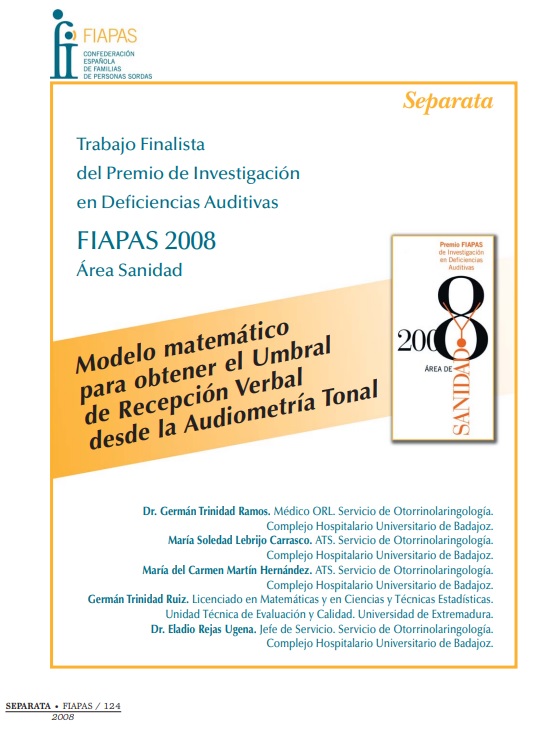Shortlisted Work
MATHEMATICAL MODEL TO OBTAIN THE SPEECH DETECTION THRESHOLD FROM PURE TONE AUDIOMETRY
Words are made up of phonemes and these of formative frequencies that must be tonotronically identified, taking advantage of the frequent specialisation of the organ of Corti and of the nerve pathways to the Primary Area of the cerebral cortex. Phonemes have one or more fundamental frequencies within their forming components that make them different from the others, thereby allowing localised stimulation in certain cochlear and nerve areas, as an identifiable sound code for the listener.
When something damages the auditory system, it can lead to a lack of identification of those sounds and thus a decrease in language discrimination: this is hearing loss, which must be corrected by a prosthetic adaptation that acts as a sound amplifier system. But this amplification cannot be indiscriminate, as this would stimulate cochlear zones that might be normal. This situation is solved within the prosthetic adaptation with output gain limiters, but a frequency adjustment is also required so that damaged areas receive a sound that is amplified enough to be useful.
There are many methods of prosthetic adaptations that attempt to scientifically solve the problem of adapting prosthetic amplification to actual loss, especially since digital prostheses allow for independent signal treatment at each frequency.
In general, all approaches based on the limitation of gain by some type of calculation or formulation have the following common goals:
- Limit the appropriate gain to reach the functional threshold close to normal hearing
- Limit a comfortable volume for the average speech spectrum
- Limit maximum gain within the dynamic range
- Limit parameters that restore sound sensation
- Limit amplified speech to the maximum comfort level within speech frequencies
- Limit the gain considering the threshold of discomfort
All of these limiting methods scientifically seek the ideal audiometric profile for an adequate response to prosthetic amplification, based on the patient’s pure tone audiometry. It is taken for granted in all of them that the ultimate goal is not to achieve the best hearing but the most comfortable, with the maximum discrimination possible.
It is therefore necessary for sound amplification to be appropriate to allow for the differentiation of formants from each of the phonemes making up words. Today’s digital prostheses have adequate flexibility to allow for selective amplification by frequency bands that correspond to the spoken language spectrum. In the case of children, where the already difficult prosthetic adaptation becomes even more complicated, this adaptation should preferably use speech tests.
The purpose of this study is to verify whether there is a relationship between pure tone audiometry and speech audiometry and, once this has been found, whether there is a mathematical model that allows a Speech Detection Threshold to be deduced from a pure tone audiometry.
Reference: Trinidad et al. (2008): “Mathematical model to obtain the Speech Detection Threshold from Pure Tone Audiometry”. FIAPAS Journal, September-October 2008, No. 124, FIAPAS Supplement.
